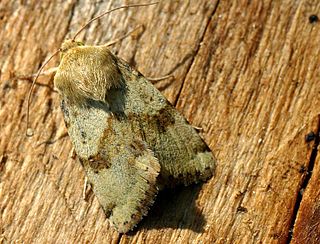Related Research Articles

Heliothis viriplaca, the marbled clover, is a moth of the family Noctuoidea. It is found in Europe and across the Palearctic to Central Asia then to Japan, Korea and Sakhalin. In the south, it penetrates to Kashmir and Myanmar. As a migratory moth, it also reaches areas in northern Fennoscandia in some years. North of the Alps, both indigenous and immigrant individuals occur in certain areas. The heat-loving species occurs mainly on dry grasslands, fallow land, heathlands and sunny slopes and slopes and the edges of sand and gravel pits.
Dichomeris ampycota is a moth of the family Gelechiidae. It was described by Edward Meyrick in 1913. It is known from Sri Lanka.
Garrha agglomerata is a moth in the family Oecophoridae. It was described by Edward Meyrick in 1920. It is found in Australia, where it has been recorded from South Australia.
Helcystogramma symbolica is a moth in the family Gelechiidae. It was described by Edward Meyrick in 1914. It is found in Guyana.
Charistica ioploca is a moth in the family Gelechiidae. It was described by Edward Meyrick in 1922. It is found in Amazonas, Brazil.
Dissoptila prozona is a moth in the family Gelechiidae. It was described by Edward Meyrick in 1914. It is found in Guyana.
Battaristis ichnota is a moth of the family Gelechiidae. It was described by Edward Meyrick in 1914. It is found in Guyana.
Battaristis prismatopa is a moth of the family Gelechiidae. It was described by Edward Meyrick in 1914. It is found in Guyana.
Compsolechia thysanora is a moth of the family Gelechiidae. It was described by Edward Meyrick in 1914. It is found in Peru.
Compsolechia caryoterma is a moth of the family Gelechiidae. It was described by Edward Meyrick in 1922. It is found in Amazonas, Brazil.
Idiophantis chiridota is a moth of the family Gelechiidae. It was described by Edward Meyrick in 1914. It is found in Sri Lanka, Thailand, on the Sunda Islands and Fiji.
Dinochares conotoma is a moth in the family Lecithoceridae. It was described by Edward Meyrick in 1908. It is found in Sri Lanka.
Epimactis infulata is a moth in the family Lecithoceridae. It was described by Edward Meyrick in 1914. It is found in Sri Lanka.
Depressaria panurga is a moth in the family Depressariidae. It was described by Edward Meyrick in 1920. It is found in South Africa.
Eutorna caryochroa is a species of moth in the family Depressariidae. It was described by Edward Meyrick in 1889. It is endemic to New Zealand.
Gonionota comastis is a moth in the family Depressariidae. It was described by Edward Meyrick in 1909. It is found in Peru and Colombia.
Anchinia porphyritica is a moth in the family Depressariidae. It was described by Edward Meyrick in 1914. It is found in Assam, India.
Pseuderotis thamnolopha is a moth in the family Depressariidae. It was described by Edward Meyrick in 1932. It is found in Costa Rica and Guatemala.
Antaeotricha coriodes is a moth in the family Depressariidae. It was described by Edward Meyrick in 1915. It is found in Guyana.
Moca aphrodora is a species of moth in the family Immidae first described by Edward Meyrick in 1922. It is found in Brazil and Peru.
References
- ↑ Savela, Markku, ed. (January 8, 2017). "Epimactis turbida Meyrick, 1914". Lepidoptera and Some Other Life Forms. Retrieved August 28, 2020.
- ↑ Journal of the Bombay Natural History Society. 22 (4): 779.